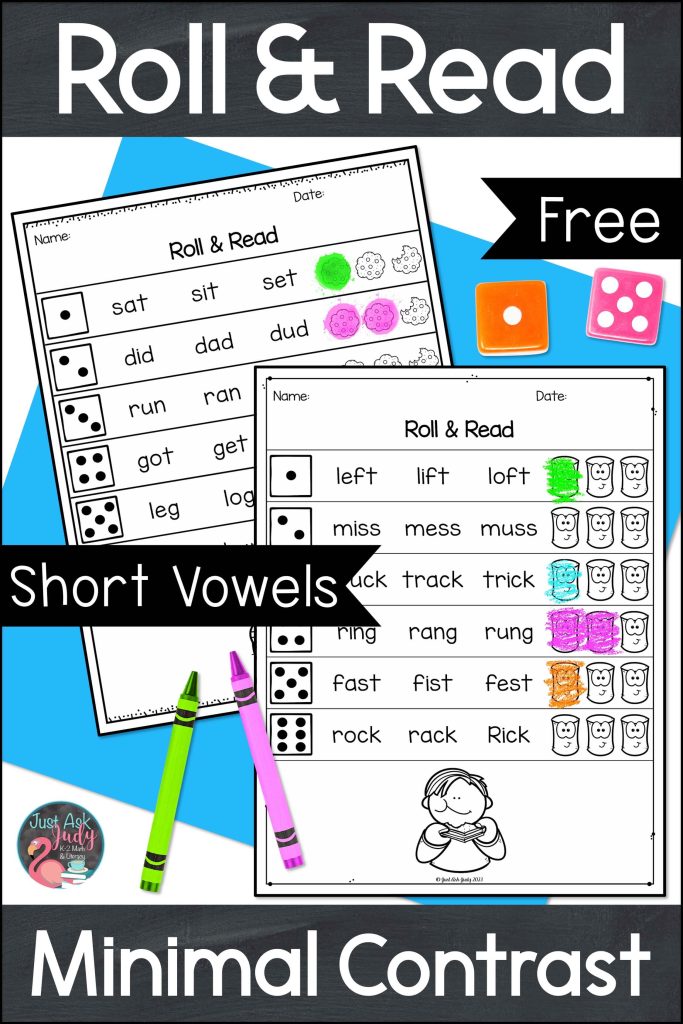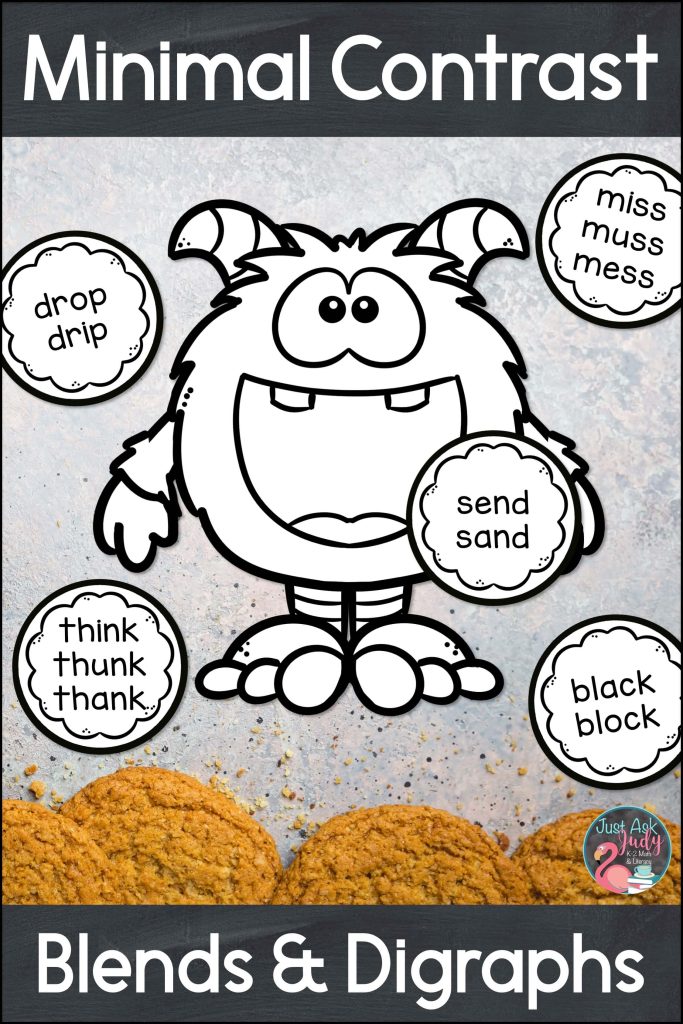Take a minute or two to learn about minimal pairs. You’ll find out what they are and ways you can use them for decoding. You’ll even discover a freebie to try.
Did you know that minimal pairs (or trios) are a terrific way to provide bite-sized decoding practice for your students?
What Are Minimal Pairs?
Minimal pairs or minimal contrast words are words that are similar or almost the same. They often (but not always) differ by one letter or sound. They can be different in the initial, medial, or final position of a word. The change can be an addition, substitution, or omission.

Here are some examples of minimal pairs appropriate for decoding practice.
- Initial Substitutions: bat and mat or brow and plow
- Medial Substitutions: pin and pan or prone and prune
- Final Substitutions: let and leg or slide and slime
- Additions: sip and ship, cut and cute, or bat and boat
- Omissions: flit, lit, it
You can use real words, nonsense words, or a mix of the two.
When you use minimal pairs (or trios, etc.) you’ll be giving your students a gentle reminder to look carefully at every letter when decoding words.
Why Bite-Sized Practice?
Using minimal pairs or contrast to practice decoding words is not a new idea. In fact, it is a very old idea.
I looked for but could not find a workbook for phonics practice, Remedial Reading Drills, that I had used with my students. Surprisingly, I found a copy online. The original copyright date was 1940! And no, I was not using it in 1940! Perhaps I had the 1985 revision.
What I found then, and now, is that the number of words presented on a single page can be overwhelming for some students. Even when you fold a page or cover part of it, they can feel frustrated and defeated before they even start. Some of your students, undoubtedly also have shorter attention spans than their peers. For these reasons, I found bite-sized decoding practice to be a more effective approach for my beginning and challenged readers.
Please note that there is a newer 2007 version of Phonic Reading Lessons available from Academic Therapy Publications. There are now fewer words with more spacing on the pages. My comments here are strictly about how the layout and the number of words presented on a page can affect young students and are not a reflection in any way of the instructional content or methods. You might find this presentation to be highly effective with your students.
Feed Me Activities for Minimal Pairs
By their nature, feed-me activities provide bite-sized practice. My two read-and-feed resources with minimal pairs (and trios) are an excellent way to have your students apply their decoding skills.
What Words Did I Choose?
I chose phonetically regular high-frequency short vowel words from two popular lists, one with 220 words and the other with 1000 words.
I created two resources. Feed Me S’Mores includes 10 VC words and 39 CVC words. These are the target words. The target words are presented in pairs and trios contrasted with other similar real words. The only change, typically, is the short vowel sound.

Feed Me Cookies includes 109 short vowel target words with initial and/ or final consonant blends and/ or digraphs. I also added words with double final consonants. There are two sets of minimal pairs and trios. The first set contrasts single consonants with blends and digraphs. The second set contrasts short vowel sounds.
How Will My Students Benefit?
These Feed Me activities will give your students the opportunity to:
- apply their decoding skills
- get oodles of practice in bite-sized chunks
- gain automatic recognition of high-frequency words
- develop a sight word vocabulary
- increase their accuracy and fluency
And don’t forget the inherent motivation and fun!
What Prerequisite Skills Do My Students Need?
This is a practice activity that is designed to be a follow-up to your direct phonics instruction. It is intended to help your students achieve mastery in decoding accuracy and/ or automatic recognition of the target words. With that in mind, your students will need to…
For CVC Words
- have near mastery with letter/ sound knowledge of consonants and short vowels
- be able to blend 2 and 3 phonemes to decode VC and CVC words with a developing level of accuracy
For Blends and Digraphs
- have near mastery with letter/ sound knowledge of consonant digraphs
- be able to blend 3, 4, and 5 phonemes to decode CCVC, CVCC, and CCVCC words with a developing level of accuracy
How Can I Use This Minimal Pairs Activity?
Try this activity:
- with your small instructional, intervention, or resource groups
- when tutoring individual students
- in a center
It’s perfect to use for:
- a warm-up
- an exit activity
- practice
- review
Get ‘Em Decoding
Your students will take turns to:
- Pick a card.
- Read the minimal pairs or trios on the s’more or cookie.
- Feed the s’more or cookie to the hungry bear or monster.
- Color a s’more or cookie on the optional reward strip.
Roll & Read Minimal Contrast Short Vowel Words
Here’s a little roll & read freebie so you can try out decoding with minimal pairs. Or use it as an add-on to my feed-me activities for even more practice with those high-frequency phonetically regular short vowel words.
For this activity, I chose 18 short vowel words without consonant blends and digraphs and 18 short vowel words with initial and/ or final consonant blends and/ or digraphs for the target words. All of the target words came from the same two lists of high-frequency words.
The target words are presented in trios contrasted with other similar real words. The target word is the first one in each row. The only change is the vowel letter.
Get ‘Em Reading
Your students will:
- Roll a die.
- Find the corresponding row of words.
- Read each word in the row.
- Color one cookie or marshmallow at the end of each row.
- Roll and read again, and again, and again! Color a cookie or a marshmallow each time you read a row.
- Play until each row has been read one time or one row read three times, or time is up!
For students who are overwhelmed or lose focus, reduce the number of rolls and/ or spread out the practice over 2 or 3 sessions.

Click on the highlighted words to download your free copy of Roll & Read Minimal Contrast Short Vowel Words.
More Ways to Incorporate Minimal Pairs For Decoding Practice
You can easily incorporate bite-sized decoding (reading) and encoding (spelling) practice with minimal pairs when using letter/ sound mats. These two blog posts will help you start thinking about how you can do this.
Bonus: Discover another free roll & read activity!
Word ladders and making words activities are two more bite-sized ways to work with minimal contrast words, particularly for encoding.
More Decoding Practice With Phonetically Regular High-Frequency Words
Check out these two blog posts for information on orthographic mapping and rapid word recognition charts. Help your students to develop automatic word recognition using words from the same high-frequency word lists.
- Do You Want to Know All About Rapid Word Recognition Charts?
- Are You Curious About the Importance of Orthographic Mapping?
You can also head directly to my TPT store to check out these products.
- CVC Rapid Word Charts For Automatic Word Recognition of High-Frequency Words
- CVC Word Mapping – Phoneme Grapheme Matching With High-Frequency Words
- CVC Words – Minimal Contrast Short Vowel Word Decoding Activity
- Consonant Blends and Digraphs – Rapid Word Charts With High-Frequency Words
- Consonant Blends and Digraphs – Minimal Contrast Words Decoding Activity
What is your experience with using minimal pairs for decoding? How do you provide bite-sized practice? Share your thoughts and experiences in the comments!


Leave a Reply